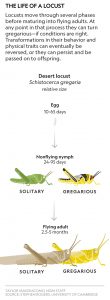Locust attack
About:
- Locusts are insects related to grasshoppers, these insects form enormous swarms (dense group of flying insects) that spread across regions, devouring crops and leaving serious agricultural damage in their wake.
- They have big hind legs than grasshoppers which gives them greater thrust to hop and fly.
- They have two phases in life: solitary phase and gregarious phase.
- During dry spells, solitary locusts are forced together in the patchy areas of land with remaining vegetation, but when rains return—producing moist soil and abundant green plants—those environmental conditions create a perfect storm: Locusts begin to produce rapidly and become even more crowded together.
- In these circumstances, they shift completely from their solitary lifestyle to a group lifestyle in what’s called the gregarious phase. Locusts can even change color and body shape when they move into this phase. Their endurance increases and even their brains get larger.

- Locust swarms are typically in motion and can cover vast distances—some species may travel 130 km or more a day.
- There can be about 180 million locusts in a swarm.
- They travel during the day and rest in the night. But wherever they settle, they destroy every crop.
- Each locust can eat its weight in plants each day, so a swarm of such size would eat 423 million pounds of plants every day.
Prevention
- They can be controlled to certain extent by spraying pesticides.
- They can be threatened away by making loud sounds.
- They can be collected and can be used in the poultry industry as they are a good source of protein.
Why in the news?
- The states of Rajasthan, Madhya Pradesh, Uttar Pradesh and Chhattisgarh are experiencing locust attack.
- These locust swarms have been travelling from African region, and entered Indian subcontinent because of favourable winds.
- Proper control of these swarms is necessary to avoid plagues caused by their destruction.
Subscribe
Login
0 Comments
